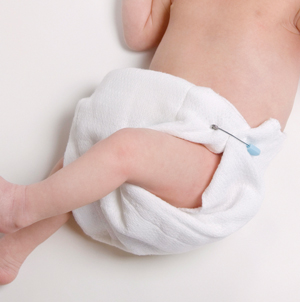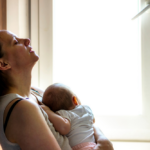The bottom line
I would consider myself to be someone with a fair […]

So I did what any modern mom would do: I googled. After typing phrases like “how do I cloth diaper?” and “no, seriously, I know nothing about cloth diapering and my baby is coming in three weeks what do I do?” into the search engine, I stumbled upon a fantastic resource in the form of a series of YouTube videos, all produced by cloth diapering guru and mom of three Jaimee Gleisner. The seven-part sequence called “Cloth Diapering 101” had garnered an average of 30,000 views per clip, and covered all the basics including the various types of cloth diapers, the accessories needed, instructions for laundering and more. Bingo! I had found the motherlode. Gleisner’s easy-to-follow instructions were just the ticket for a newbie like me. Now I’d like to pass them on to you (with Gleisner’s help).
First things first
Getting started is the hardest part when you’re approaching anything new. But whether your baby is already born or you’re still waiting on D-day, you can wade into the shallow end of the pool before jumping in with both feet. “I always suggest getting a variety of diapers because you just never know what you’ll end up liking best,” says Gleisner. “Try a variety of styles as well as brands. You wouldn’t want to buy 24 of one type and brand of diaper only to find out you don’t like them or they just don’t work for your baby.” And you may not even have to purchase the diapers you try to get a good feel for your preference. Advises Gleisner, “If you can borrow diapers to try out, this is a great way to determine what you like without the investment.” Or if the thought of used nappies doesn’t appeal to you, there are other alternatives. “Some diaper stores offer trial packages with a variety of diapers in them that you can rent or try out and return those that do not work for you,” explains Gleisner, suggesting jilliansdrawers.com and diaperjunction.com as good places to start.
Get it together
OK, you’ve got the diapers you want to trial run, you’ve got the baby, the baby’s got the … well, you know. Now what? First, you’ll want to gather the necessities you’ll need for a successful cloth career. Gleisner shares her must-have list:
The basics
Diaper-safe detergent. When it comes to washing diapers, not all soaps are created equal. Visit pinstripesandpolkadots.com or diaperjungle.com for exhaustive lists of detergent brands and how they measure up for cloth cleaning.
Wet bag. A cloth bag with a waterproof lining to corral your wet and/or soiled diapers. You’ll need two, so that you’ll have an extra when one’s in the wash.
Diaper pail. You can use a traditional pail or a lidded trash can. Whichever one you choose should be lined with your wet bag.
Travel-size wet bags. For use on the go in the diaper bag. Additionally, there are accessories that can enhance your routine or make the process even greener.
The extras
Flushable liners. Thin strips that are positioned atop the absorbent layer. These make removing solid waste easier and can be disposed of in the toilet.
Cloth wipes and wipe solution. If you want to go all green, you can make or buy your own wipes and wipe solution. Just a simple cotton cloth cut into squares works for wipes, and a mixture of oil, soap, essential oils and water works well for a spray-on solution.
Enzyme spray. A stain-removing spray to use before laundering your diapers.
Doublers. Another absorbent layer added to the diaper for extra soaking power; good for nighttime diapering.
Diaper pail deodorizer. Buy or make a hanging satchel of baking powder or other deodorizing substance to help neutralize any lingering smells.
Diaper sprayer. A hose with a nozzle that can be attached directly to the base of your toilet to help spray poop into the toilet and keep it out of the washing machine.
It’s a wash
Once you’ve used them, it’s time to get them clean again. Gleisner offers a step-by-step guide for laundering your diapers, plus a few dos and don’ts for proper handling.
1. Shake solid poop into toilet. If using a disposable liner, simply lift out of the diaper and flush. Anything that doesn’t fall off can go into the diaper pail.
2. Spray poop diapers with an odor remover (such as Bac Out) to combat odor.
3. Toss diaper in diaper pail/bag. If you’re using pocket diapers, be sure to shake the insert loose before adding a diaper to the pail.
4. Load the washing machine with soiled diapers and run a prewash or rinse/spin cycle with cold water using no detergent.
5. Run a regular, heavy-duty cycle with hot water and about one tablespoon detergent (follow package directions if you have an HE front loading washer).
6. Check the rinse cycle to make sure there are no suds. If suds are present, run an extra rinse cycle on cold (and use less detergent next time).
7. Tumble dry on low or hang dry.
- Do wash anything that touches baby’s skin after each use. Set covers aside to air dry.
- Don’t use fabric softener or pure soap products on your cloth diapers.
- Don’t use bleach or expose to high heat for prolonged periods of time.
- Don’t use any diaper rash ointments with petroleum, petrolatum, lanolin or fish oil products.
- Don’t use any “baby” detergents with fragrances or fabric softener.
If you notice a lingering odor after washing your diapers, or if they are no longer absorbing adequately, it may be time to “strip” them. Visit pnmag.com/clothdiapering for Gleisner’s recommended stripping method.
How it all came out in the end
It’s been nearly a year since I swaddled my baby’s bum in cloth for the first time, and we’re still going strong. It only took one wearing and washing cycle before I felt like I was in the swing of things. And we aren’t whole hog clothers, either—we still buy disposables from time to time. Don’t feel like you have to go all out or choose one over the other. (I am certainly grateful for disposables when laundry feels overwhelming.) Start slowly, if you need to. Begin by using cloth at night, or as the first diaper of the day. Find other moms who cloth diaper and ask questions. Figure out how cloth works for you. With time, you’ll strike upon just the right diapering balance for your lifestyle.







